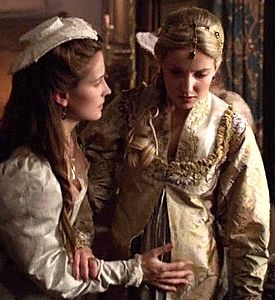
Back in 2014, I wrote a post about this event, but since I focused on the importance of the event rather than its details, I am taking the opportunity to revisit the topic.
So let’s start with the specifics: Jane’s pains began on the afternoon of October 9th, and Edward was born at two in the morning on the 12th. She did not have an easy time of things. – and her efforts were quickly commemorated in a contemporary ballad (there’s more, but this is the relevant part):
The queen in travail, pained sore
Full thirty woeful hours and more;
And no ways could relieved be,
As all her ladies wished to see;
Wherefore the king made greater moan
Than ever yet his grace had done
Agnes Strickland, Lives of the Queens of England (Volume V – Jane Seymour)
Now, thirty hours is only one-and-a-quarter days, so that was still on the early side. After her labor had dragged on for the second day, there was a solemn procession in London to pray for her as described in Wriothesley’s Chronicle (yes, I cleaned up the language – but the link will take you to the original):
This year, the 11th day of October, Anno 1537, and the 29th year of the reign of King Henry the Eight, being Thursday, there was a solemn general procession in London, with all the orders of friars, priests, and clerks going all in copes, the major and aldermen, with all the crafts of the City, following in their liveries, which was done to pray for the Queen that was then in labor of child.
https://archive.org/details/achronicleengla04hamigoog/page/n127/mode/2up
Finally, more than fifty hours after it all began, Jane’s son was born on the eve of the Feast of St. Edward (which caused some to joke that he had deliberately tarried until then….). Things went really well after that – until they didn’t. After Jane’s death, people got (quietly) mean about things. There was talk that she had been poorly cared for, that Henry had not provided for her well enough… It was somewhat irresistible to blame Henry given that three of his wives died within two years of each other, and it got even more irresistible after people saw what happened to the next three. Among the meanest of the “reporting” was done in 1585 by a Catholic writer, Nicholas Sander (who was hostile to the King for breaking with the Pope). He’s the one who claimed that, when Jane Seymour
‘was in severe labour in a difficult childbirth, all her limbs [were] stretched for the purpose of making a passage for the child, or (as others stated) having the womb cut before she was dead, so that the child which of the two lives was to be spared. He answered, the boy’s, because he could easily provide himself with other wives.’
Jennifer Loach, Edward VI
Now, we know that could not have happened since Jane lived for twelve days after the birth. Yet, with our hindsight, I suspect that none of us would put it past Henry to make that call if he had in fact been asked….
***
If you like my posts, you’ll love my books! My Seymour Saga trilogy tells the gripping story of the short-lived dynasty that shaped the Tudor Era. Jane the Quene skews romantic, The Path to Somerset is pure Game of Thrones (without the dragons), and The Boy King is a noir coming-of-age. Get them now through Amazon, Barnes & Noble, Kobo, and Apple, or even your local independent bookstore!

(PS Already read them? Did you love them? Then please review them – even just a stars rating! It makes a huge difference in helping new readers find them and would mean the world to me!)
Dear Janet,
I have now finished all three books of the Seymour trilogy (with great pleasure). I thought your description of Jane’s labor was insightful. As a mother of three, you have surely been there/done that. I certainly hope that your birthings were not as difficult as Jane’s, and you did have the advantages of modern medicine including antibiotics to ward off puerperal fever. But oregano oil and oil of Seville oranges are pretty good antibiotics and should have been available; I wonder if Jane’s doctors knew about them? The same goes for treatment of Henry’s suppurating leg. Roman and even ancient egyptian doctors knew about the use of these oils in treating wounds, as well as the use of honey to provide aseptic conditions. (There is now a special New Zealand honey called manukah honey that has even stronger antibiotic properties, just in case you need a good natural antibiotic).
I think Henry’s court physicians were somewhat behind the state-of-the-art. And Henry grinding up pearls as a salve is just purely antagonistic to the most informed medical thinking of his day. Queen Elizabeth used the services of a muslim physician – medicine in the Islamic world was more advanced than in the west, and probably far more advanced than that in England. But in dealing with Henry VIII, a physician dared not take any chances with a remedy Henry did not know about. And so, Henry’s overweening authority in the end killed both Jane and himself, though few would have been able to blame him or her.
I also want to ask you – were you raised Catholic? Your detailed knowledge of Catholic ritual suggests it.
Thankfully my own labors were MUCH easier and drug-filled than Jane’s (though my first did go on for far too long….). And yes, I agree that Henry’s micro-managing of medical issues didn’t do anyone any good (I believe he probably knew about the oils – they just didn’t work so he moved on to pearls!). And yes, I was raised Catholic 😉